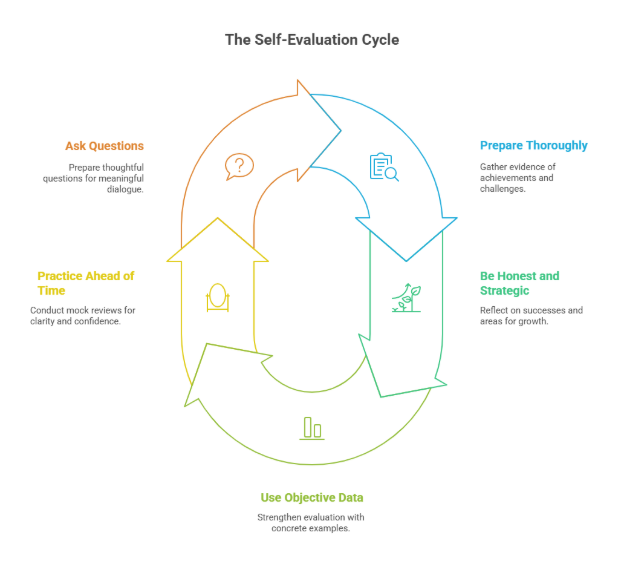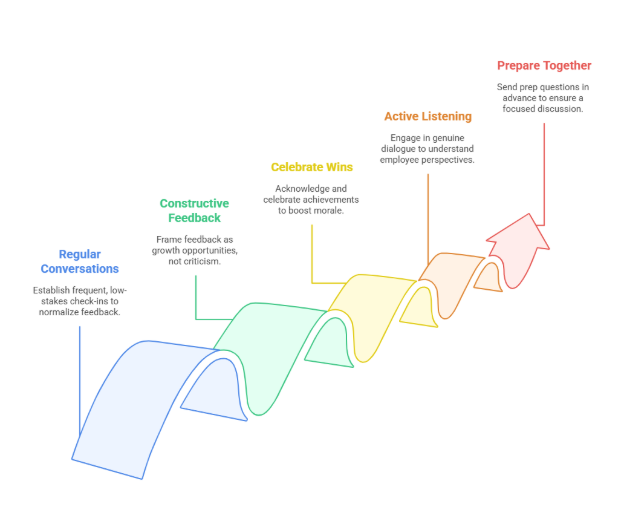The Power and Purpose of Performance Reviews

 26 June,2025
Share
26 June,2025
Share
Performance reviews are not just HR formalities—they are essential tools that shape an organization’s culture, productivity, and long-term success. A well-executed performance review system helps ensure that employees are recognized for their contributions, receive the support they need to improve, and remain aligned with the organization’s evolving goals. These reviews also help identify leadership potential, training needs, and opportunities for career advancement.
In today’s dynamic workplace, where hybrid environments and rapid change are the norm, performance reviews act as anchors that bring structure, feedback, and clarity to employees’ roles. By incorporating regular feedback cycles, organizations can reduce disengagement and increase retention—two top concerns for modern leaders.
Moreover, performance reviews foster accountability and transparency. Employees who understand how their performance is measured and what is expected of them tend to take greater ownership of their results. At the same time, they feel more supported when they see their employer is invested in their success.
A successful performance review process isn’t only about what has been done—it’s equally about what comes next. It turns evaluation into a partnership for development and goal setting. When thoughtfully implemented, performance reviews can transform workplace culture and drive both personal and organizational growth.
Common Goals of Effective Performance Reviews
The most effective performance reviews are designed with clear, multifaceted goals that benefit both employees and the organization. One of the foundational objectives is to provide constructive feedback that helps individuals understand their strengths and identify areas where they can improve. Without this clarity, performance can stagnate, and employees may feel lost or unsupported.
Another core goal is to strengthen alignment between individual efforts and company-wide objectives. Reviews create an opportunity to communicate how an employee’s contributions tie into broader business strategies and outcomes. This not only enhances motivation but also reinforces purpose and direction.
Performance reviews also function as a talent development tool. They identify employees who are ready for more responsibility or new challenges and those who may benefit from additional coaching or resources. When feedback is documented and structured over time, organizations can track progress and offer well-informed career pathing.
They’re also an avenue to address concerns early, helping managers detect potential performance issues before they become detrimental. This proactive approach can save time, morale, and resources.
Finally, performance reviews are an opportunity for employee voice. Inviting team members to share feedback on their experiences and challenges fosters a culture of open communication and continuous improvement.
Cadence & Format: Annual, Quarterly, Monthly—or Even Weekly?
Choosing the right cadence and format for performance reviews can greatly influence their effectiveness. While traditional annual reviews are still used by many companies, they are increasingly seen as outdated and insufficient for the pace of today’s work environments. One of the challenges with annual reviews is the time lag—important events, both positive and negative, may be forgotten or misrepresented when discussed months later.
Modern performance management systems favor more frequent, lighter-touch check-ins, such as quarterly or monthly reviews. These allow managers and employees to stay continuously aligned, adjust goals in real-time, and respond quickly to performance trends. In fact, companies that embrace continuous feedback cycles often report higher levels of engagement and productivity.
Bi-weekly check-ins are especially useful for fast-moving teams or organizations undergoing rapid change. These micro-reviews foster agility and accountability. They help address roadblocks early and enable employees to course-correct before challenges become larger problems.
Companies also differ in how structured or informal their reviews are. Some rely on formal written evaluations with scorecards, while others embrace more casual one-on-one discussions. The key is consistency and clarity.
Ultimately, there is no one-size-fits-all approach. The most effective cadence and format depends on company culture, team structure, and performance expectations.
Anatomy of a Performance Review
A truly effective performance review is not just a conversation—it’s a strategic dialogue rooted in preparation, honesty, and forward-thinking. The anatomy of a review can vary between organizations, but there are several core components that should always be included.
It begins with preparation. Managers must review performance data, goals, and feedback from colleagues to paint a complete picture of an employee’s performance. Likewise, employees should prepare by reflecting on their own achievements, challenges, and development needs. Both parties should come to the table with insights, not surprises.
A strong review also includes self-evaluation. Encouraging employees to assess their own performance fosters self-awareness and personal accountability. It’s a great way to compare perspectives and spark discussion.
The heart of the review lies in two-way feedback. Managers provide structured observations, but they should also invite employees to share what support they need and how they view their own performance. This open communication builds trust and shows employees that their voice matters.
Next, the review should establish SMART goals—those that are specific, measurable, achievable, relevant, and time-bound. Goal-setting is essential for ensuring accountability and growth between reviews.
Finally, the conversation should end with acknowledgement and action. Celebrate accomplishments, clarify next steps, and document outcomes to maintain momentum moving forward.
Ready to transform your performance review process?
Partner with Neuronimbus to build smart, scalable, and employee-first solutions.
Transform Today
Performance Reviews vs. Self‑Evaluations

Benefits of Self‑Evaluation
Self-evaluations encourage employees to reflect honestly on their own performance, recognize accomplishments, and acknowledge areas of growth. They promote transparency and open dialogue, helping managers better understand an employee’s self-perception. This process also builds accountability and ownership, empowering employees to take charge of their development.
Common Pitfalls
Self-evaluations can sometimes lead to exaggerated claims or overly modest appraisals, depending on the employee’s confidence level. When these assessments differ significantly from a manager’s review, it may cause friction or confusion. It’s essential for organizations to provide clear guidelines and support to ensure balanced, honest self-assessments.
Tips for Robust Self‑Evaluation
Prepare Thoroughly: Gathering evidence of achievements and challenges helps structure a comprehensive and honest review. It sets the foundation for a balanced discussion with your manager.
Be Honest—and Strategic: Reflect on successes and areas for growth while aligning your narrative with your long-term career goals and team contributions.
Use Objective Data: Concrete examples such as KPIs, project outcomes, or client feedback strengthen your evaluation and lend credibility to your claims.
Practice Ahead of Time: Conducting a mock review enables clarity and confidence, ensuring you address key talking points without being caught off guard.
Ask Questions: Preparing thoughtful questions in advance shows initiative and fosters more meaningful, two-way communication during the actual performance review.
What Does Good Look Like? Performance Review Examples
The Struggling Contributor
This employee shows dedication but faces challenges with performance consistency or communication. Reviews should highlight their effort and encourage progress through training or more structured guidance. The goal is to support improvement while maintaining motivation and clarity on expectations.
The Top Performer
Top performers consistently exceed expectations and often take initiative beyond their role. Their reviews should focus on retaining their motivation, recognizing their leadership potential, and offering advanced growth opportunities. These employees may benefit from strategic projects or mentoring responsibilities.
The Mid‑Level Steady Performer
This employee consistently meets job expectations but may lack standout achievements. Reviews for steady performers should encourage stepping outside comfort zones—like leading new initiatives or cross-functional projects—to foster development and showcase untapped potential.
The Creative Innovator
Creative thinkers drive innovation and problem-solving but may struggle with structure or follow-through. Performance reviews should balance celebrating their creativity with helping them build processes and execution skills. Managers can guide them with frameworks for accountability and clearer timelines.
Making Reviews Less Nerve‑Wracking

Keep conversations regular and low-stakes
One major reason employees dread performance reviews is because they feel like infrequent, high-pressure events. By making these discussions more regular—such as bi-weekly or monthly—managers reduce anxiety and normalize feedback as a helpful, supportive process. Low-stakes check-ins ensure that issues are addressed in real time, not accumulated into one overwhelming meeting. These shorter conversations also promote transparency, helping employees better understand expectations and build trust with their leaders over time.
Frame feedback constructively, emphasizing growth over criticism
Feedback should be a tool for progress, not a personal judgment. Managers who frame their feedback with a growth mindset focus on how employees can improve and achieve more, rather than simply pointing out mistakes. Constructive feedback includes suggestions, positive reinforcement, and clear reasoning, making it feel like an opportunity rather than a reprimand. Employees are far more receptive when the tone is encouraging and collaborative, creating a safe space to grow without fear of harsh judgment.
Celebrate wins before diving into development
Recognizing accomplishments at the beginning of a performance review sets a positive tone and reinforces desirable behaviors. Celebrations show employees that their hard work is appreciated and noticed, which increases motivation and engagement. It also builds rapport and makes it easier to have open discussions about areas of improvement. This approach helps maintain a balanced perspective—reminding employees that they’re not defined by their weaknesses but recognized for their contributions.
Actively listen to employees’ perspectives
An effective performance review is a dialogue, not a monologue. Managers must actively listen to employees—giving them time and space to express their views, challenges, and aspirations. By genuinely hearing what employees have to say, managers build trust and uncover valuable insights that might otherwise go unnoticed. This kind of mutual communication ensures that the review is personalized, balanced, and supportive, and it empowers employees to feel like active participants in their own growth.
Prepare together: Send prep questions in advance to avoid surprises
Preparation is crucial to a successful and stress-free review. Sending guiding questions to employees ahead of time allows them to reflect, organize their thoughts, and come to the meeting with examples and feedback. This transparency helps manage expectations and ensures that the review covers the most relevant topics. It also encourages employees to take ownership of their performance and reduces the likelihood of confusion, defensiveness, or disengagement during the conversation.
Best Practices to Improve Performance Review Outcomes
Train managers in giving clear, empathic, actionable feedback
Not all managers are naturally skilled at giving feedback, and untrained managers may inadvertently demotivate employees. Organizations must provide training to ensure managers are prepared to deliver performance reviews that are both clear and empathetic. This means helping them develop strong communication skills, emotional intelligence, and the ability to provide feedback that’s specific, actionable, and non-judgmental. With proper training, managers can guide employees with clarity and compassion, fostering development instead of discouragement.
Use data-driven metrics where possible—reduce subjectivity
Incorporating measurable, objective data into performance reviews helps eliminate bias and adds credibility to the evaluation process. Metrics such as sales numbers, customer satisfaction scores, project completion timelines, and efficiency benchmarks offer concrete evidence of performance. This objectivity ensures that feedback is fair and aligned with results, not just personal impressions. Data-driven reviews also make it easier to track progress over time and justify decisions around compensation, promotions, or development planning.
Make reviews cumulative, not just retrospective—connect them to future growth
Many performance reviews focus only on what’s already happened, which can feel backward-looking and unproductive. Instead, the best reviews take a cumulative approach, acknowledging past performance while tying it into future goals and plans. This forward-thinking focus helps employees understand where they’re going next, what’s expected of them, and how they can grow. By connecting performance history with future aspirations, reviews become strategic and motivational rather than simply evaluative.
Keep written records to ensure continuity and fairness
Documenting performance review discussions ensures that there’s a clear, traceable record of feedback, agreements, and action plans. This documentation is important for maintaining consistency across teams and time periods, and it provides a safeguard against misunderstandings or disputes. Written records also serve as useful reference points during future reviews, promotions, or HR assessments. Fairness improves when both managers and employees can look back on what was discussed, agreed upon, and achieved.
Tie outcomes to development resources: workshops, mentoring, stretch projects
The most effective reviews don’t stop at identifying areas for improvement—they also link those areas to specific development opportunities. Whether it’s enrolling in a skills workshop, assigning a mentor, or giving access to a stretch project, actionable support shows a commitment to employee growth. This turns feedback into real-world learning and creates a direct path for advancement. Employees feel more valued when their company invests in tools that help them succeed.
Promote peer recognition to foster a supportive culture
Encouraging peer feedback and recognition makes performance reviews more holistic and inclusive. When colleagues acknowledge each other’s efforts, it builds team morale and creates a culture where great work is consistently seen and appreciated. Peer input can highlight contributions that managers might miss and provides additional context during evaluations. A supportive culture also increases engagement, as employees feel respected and encouraged by those they work with daily.
How Can Neuronimbus Help?
Neuronimbus is a digital transformation and experience design company that helps organizations modernize their internal systems, including employee performance management. Through its custom enterprise solutions and digital platforms, Neuronimbus offers a range of tools and services designed to elevate how performance reviews are conducted—making them more insightful, data-driven, and employee-centric. With deep expertise in UX/UI, software development, and business process automation, Neuronimbus can build tailored HR and performance management systems that integrate seamlessly with existing workflows. These systems can include real-time feedback modules, intelligent goal tracking, and dashboards that provide visibility into team and individual performance over time. Additionally, Neuronimbus leverages AI and analytics to identify skill gaps, track development milestones, and offer predictive insights into workforce trends. Their services don’t stop at technology; they also provide consulting and strategy support to help organizations rethink their review structures, integrate continuous feedback mechanisms, and improve employee engagement. Whether a company wants to replace outdated annual review models or develop a modern, mobile-friendly self-evaluation tool, Neuronimbus has the design and development capabilities to deliver. Their agile approach ensures that businesses can implement scalable, secure, and user-friendly performance management platforms tailored to their unique culture and goals. By partnering with Neuronimbus, organizations can turn performance reviews from administrative tasks into meaningful, strategic engagements that boost productivity, foster growth, and retain top talent. Their comprehensive digital services ensure that performance management becomes a strength; not a stress, for today’s dynamic teams.
Categories
Quick Contact
LET'S REINVENT TALENT MANAGEMENT
Contact us to book a demo and see how NeuroTal can help your organisation.

© 2024-25. Neuronimbus Digital Pty Ltd. All Rights Reserved.

